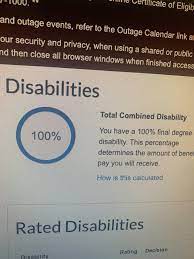Title: Understanding Benefits for 100% Total and Permanent Disabled Veterans
Introduction:
Veterans who have served our nation with unwavering dedication and have suffered significant disabilities as a result deserve comprehensive support. In recognition of their sacrifice, the U.S. Department of Veterans Affairs (VA) provides a range of benefits for 100% total and permanent disabled veterans. These benefits aim to assist disabled veterans in rebuilding their lives and ensuring a secure future. This article aims to shed light on the various benefits available to these courageous individuals.
Disability Compensation:
One of the primary benefits for 100% total and permanent disabled veterans is disability compensation. This financial assistance is designed to compensate veterans for the loss of earning capacity resulting from their service-connected disabilities. The compensation amount varies based on the severity of the disability, with higher rates provided for those with dependents.
Healthcare Benefits:
Disabled veterans are eligible for comprehensive healthcare benefits through the VA healthcare system. This includes access to medical services, specialized treatments, prescription medications, mental health care, and rehabilitation programs. These benefits ensure that disabled veterans receive the necessary medical care without incurring significant financial burdens.
Vocational Rehabilitation & Employment (VR&E):
The VR&E program assists disabled veterans in overcoming barriers to employment or establishing their own businesses. Through this program, eligible veterans receive vocational counseling, education or training programs, job placement assistance, and support services like adaptive equipment or modifications.
Dependents’ Educational Assistance (DEA):
Disabled veterans rated at 100% total and permanent disability may transfer their educational benefits to their dependents through the DEA program. This benefit offers financial assistance for pursuing higher education, vocational training, apprenticeships, or certain certification programs.
Specially Adapted Housing (SAH) Grants:
SAH grants aim to provide barrier-free living environments for severely disabled veterans by assisting them in adapting or acquiring suitable housing that meets their unique needs. These grants can cover the cost of home modifications, such as wheelchair ramps, widened doorways, or accessible bathrooms.
Automobile and Adaptive Equipment Grants:
Disabled veterans who have lost, or have limited use of, their lower extremities may qualify for grants to purchase specially adapted vehicles or adaptive equipment. These grants help improve mobility and independence by enabling veterans to operate vehicles safely and comfortably.
Conclusion:
The benefits available to 100% total and permanent disabled veterans play a crucial role in supporting their transition into civilian life. From financial compensation to healthcare coverage, educational assistance to housing grants, these benefits are designed to honor their sacrifices and provide them with the necessary resources for a secure future. It is essential for eligible veterans and their families to explore these benefits fully and take advantage of the support they deserve.
Frequently Asked Questions about 100% Total and Permanent Disabled Veteran Benefits
- Can a 100 P&T veteran get Social Security?
- What does 100 permanent and total disability mean?
- What are the benefits of being permanent and total VA disability?
- What is the difference between 100 and 100 P&T VA disability?
Can a 100 P&T veteran get Social Security?
Yes, a 100% total and permanent disabled (P&T) veteran may be eligible to receive Social Security Disability Insurance (SSDI) benefits. However, it is important to note that eligibility for Social Security benefits is determined by the Social Security Administration (SSA) and not the Department of Veterans Affairs (VA).
To qualify for SSDI benefits, veterans must meet the SSA’s criteria for disability, which includes having a severe medical condition that prevents them from engaging in substantial gainful activity and is expected to last for at least one year or result in death. The disability does not have to be related to military service but can be any medically determinable impairment.
The VA’s determination of 100% P&T disability does not automatically guarantee eligibility for SSDI benefits. The SSA has its own evaluation process and criteria that must be met. However, having a VA determination of 100% P&T disability can strengthen a veteran’s case when applying for SSDI benefits since it demonstrates the severity of their disability.
It is recommended that veterans consult with a qualified Social Security attorney or representative who can provide guidance and assistance in navigating the SSDI application process. They can help gather necessary medical evidence, complete paperwork accurately, and advocate on behalf of the veteran throughout the application and appeals process if needed.
What does 100 permanent and total disability mean?
A 100% permanent and total disability rating refers to the highest level of disability recognition given by the U.S. Department of Veterans Affairs (VA). It signifies that a veteran’s service-connected disabilities are deemed to be completely and permanently disabling, preventing them from engaging in substantial gainful employment.
To receive a 100% permanent and total disability rating, a veteran must have one or a combination of service-connected disabilities that render them unable to secure or follow a substantially gainful occupation. This rating is typically assigned when the veteran’s disabilities significantly impair their physical or mental capabilities, making it impossible for them to work and earn a living.
It is important to note that a 100% permanent and total disability rating does not necessarily mean that the veteran is completely bedridden or incapable of any activity. Rather, it indicates that their disabilities are severe enough to prevent them from maintaining regular employment.
Receiving this rating entitles veterans to various benefits, such as disability compensation, healthcare coverage through the VA system, vocational rehabilitation assistance, educational benefits for dependents, housing grants, and automobile grants for adaptive equipment.
It is crucial for disabled veterans with service-connected disabilities to work with the VA to accurately assess their level of disability and ensure they receive the appropriate benefits they deserve.
What are the benefits of being permanent and total VA disability?
Being classified as 100% permanent and total disabled by the U.S. Department of Veterans Affairs (VA) comes with several significant benefits. Here are some key advantages:
- Disability Compensation: As a 100% permanent and total disabled veteran, you are eligible for disability compensation. This financial benefit is provided to compensate for the loss of earning capacity resulting from service-connected disabilities. The compensation amount varies based on individual circumstances, such as marital status and number of dependents.
- Healthcare Benefits: Disabled veterans with a permanent and total disability rating receive comprehensive healthcare benefits through the VA healthcare system. This includes access to medical services, specialized treatments, prescription medications, mental health care, and rehabilitation programs. These benefits ensure that disabled veterans receive necessary medical care without incurring significant financial burdens.
- Dependents’ Educational Assistance (DEA): Veterans rated at 100% permanent and total disability may transfer their educational benefits to their dependents through the DEA program. This benefit provides financial assistance for dependents pursuing higher education, vocational training, apprenticeships, or certain certification programs.
- Vocational Rehabilitation & Employment (VR&E): The VR&E program supports disabled veterans in overcoming barriers to employment or establishing their own businesses. Eligible veterans receive vocational counseling, education or training programs, job placement assistance, and support services like adaptive equipment or modifications.
- Specially Adapted Housing (SAH) Grants: SAH grants aim to provide barrier-free living environments for severely disabled veterans by assisting them in adapting or acquiring suitable housing that meets their unique needs. These grants can cover the cost of home modifications such as wheelchair ramps, widened doorways, or accessible bathrooms.
- Automobile and Adaptive Equipment Grants: Disabled veterans who have lost or have limited use of their lower extremities may qualify for grants to purchase specially adapted vehicles or adaptive equipment. These grants help improve mobility and independence by enabling veterans to operate vehicles safely and comfortably.
It is important to note that the specific benefits and eligibility criteria may vary based on individual circumstances and the VA’s guidelines. It is recommended that veterans consult with the VA or a Veterans Service Officer to understand their specific benefits and how to access them.
What is the difference between 100 and 100 P&T VA disability?
When it comes to VA disability ratings, there is a distinction between being rated at 100% disabled and being rated as 100% permanent and total (P&T) disabled. Here’s an explanation of the difference:
1. 100% Disabled: A veteran who is rated as 100% disabled has been determined by the Department of Veterans Affairs (VA) to have a service-connected disability that renders them completely unable to work or earn a living wage. This disability rating indicates that the veteran’s condition is severe enough to warrant full compensation for their loss of earning capacity.
2. 100% Permanent and Total (P&T) Disabled: A veteran who is rated as 100% P&T disabled not only has a service-connected disability that renders them unable to work but also has been determined by the VA to have a permanent and total disability. The P&T designation signifies that the veteran’s condition is considered permanent, meaning it is unlikely to improve significantly over time, and it is also total, indicating that all of their service-connected disabilities are collectively evaluated as completely disabling.
The key difference between these two ratings lies in the permanence aspect. While both ratings indicate total disability, the P&T designation provides additional benefits and protections for veterans. Some notable differences include:
– Health Insurance: Veterans with a 100% P&T rating are eligible for comprehensive healthcare benefits through the VA, including free medical care, medications, and treatments.
– Dependents’ Benefits: The P&T rating allows veterans to potentially transfer their educational benefits under the Post-9/11 GI Bill to their dependents.
– Tax Exemptions: Some states offer property tax exemptions or reductions specifically for veterans with a 100% P&T rating.
– Vocational Rehabilitation & Employment (VR&E): Veterans with a 100% P&T rating may be exempt from certain eligibility requirements when participating in vocational rehabilitation programs.
It’s important for veterans to understand the specific benefits and entitlements associated with their disability rating. Consulting with a Veterans Service Officer or contacting the VA directly can provide further clarity on the benefits available to individuals with different disability ratings.


